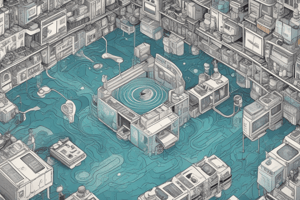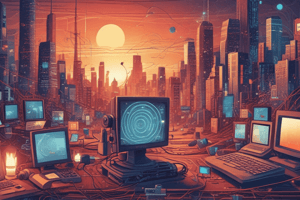Podcast
Questions and Answers
What is technology primarily defined as?
What is technology primarily defined as?
- A collection of electronic devices
- The application of scientific knowledge for practical purposes (correct)
- The field of computer science and programming
- The study of scientific phenomena
Which of the following layers is part of the Internet of Things (IoT) Ecosystem?
Which of the following layers is part of the Internet of Things (IoT) Ecosystem?
- User Interface Layer
- Application Layer (correct)
- Security Layer
- Data Collection Layer
What is the main goal of Business Process Automation (BPA)?
What is the main goal of Business Process Automation (BPA)?
- To eliminate the use of technology in processes
- To increase manual labor in business tasks
- To reduce costs and enhance productivity (correct)
- To complicate workflow efficiency
Which component of the IoT Ecosystem is responsible for transmitting data collected by the physical layer?
Which component of the IoT Ecosystem is responsible for transmitting data collected by the physical layer?
Which of the following accurately defines an IoT device?
Which of the following accurately defines an IoT device?
Which layer of the IoT Ecosystem contains sensors and networking gear?
Which layer of the IoT Ecosystem contains sensors and networking gear?
What is a key outcome often associated with the implementation of an Enterprise Resource Planning (ERP) system?
What is a key outcome often associated with the implementation of an Enterprise Resource Planning (ERP) system?
What role does analytics play in the IoT Ecosystem?
What role does analytics play in the IoT Ecosystem?
What is the primary purpose of an Enterprise Resource Planning (ERP) system?
What is the primary purpose of an Enterprise Resource Planning (ERP) system?
What does the term 'legacy systems' refer to in the context of ERP?
What does the term 'legacy systems' refer to in the context of ERP?
Why did organizations begin to adopt ERP systems in the late 20th century?
Why did organizations begin to adopt ERP systems in the late 20th century?
Which feature is NOT typically associated with modern ERP systems?
Which feature is NOT typically associated with modern ERP systems?
What was a significant evolution in the development of ERP systems in the 1980s?
What was a significant evolution in the development of ERP systems in the 1980s?
What is one reason a company might decide to implement an ERP system?
What is one reason a company might decide to implement an ERP system?
What trend has influenced the costs associated with implementing ERP systems in recent years?
What trend has influenced the costs associated with implementing ERP systems in recent years?
How does ERP technology help with compliance for businesses?
How does ERP technology help with compliance for businesses?
What aspect of an enterprise does ERP NOT fundamentally change?
What aspect of an enterprise does ERP NOT fundamentally change?
Which of the following is a characteristic of ERP systems?
Which of the following is a characteristic of ERP systems?
Flashcards
Technology
Technology
Applying scientific knowledge to create practical solutions, especially in industry.
Information Technology (IT)
Information Technology (IT)
Using computers to store, retrieve, and send information.
Internet of Things (IoT)
Internet of Things (IoT)
Connecting devices to the internet for monitoring and control.
IoT Device
IoT Device
Signup and view all the flashcards
IoT Ecosystem
IoT Ecosystem
Signup and view all the flashcards
Business Process Automation (BPA)
Business Process Automation (BPA)
Signup and view all the flashcards
ERP system
ERP system
Signup and view all the flashcards
IoT Ecosystem Layer
IoT Ecosystem Layer
Signup and view all the flashcards
Legacy Systems
Legacy Systems
Signup and view all the flashcards
Economic Order Quantity (EOQ)
Economic Order Quantity (EOQ)
Signup and view all the flashcards
Material Requirements Planning (MRP)
Material Requirements Planning (MRP)
Signup and view all the flashcards
MRP II
MRP II
Signup and view all the flashcards
ERP Adoption (21st Century)
ERP Adoption (21st Century)
Signup and view all the flashcards
Cloud ERP
Cloud ERP
Signup and view all the flashcards
ERP Growth Costs
ERP Growth Costs
Signup and view all the flashcards
ERP characteristics
ERP characteristics
Signup and view all the flashcards
ERP Needed: Growing Company
ERP Needed: Growing Company
Signup and view all the flashcards
Study Notes
Technology Overview
- Technology applies scientific knowledge for practical purposes, particularly in industry.
- It encompasses machines (like computers), techniques, processes, and programs.
- Technology is pervasive, present in homes, industries, businesses, and healthcare.
Information Technology (IT)
- IT studies and uses computer systems for information storage, retrieval, and transmission.
Internet of Things (IoT)
- IoT connects devices (computers, smartphones, appliances) to the internet.
- An IoT device is a standalone internet-connected device, remotely monitored and controlled.
- An IoT ecosystem is a complex network enabling connections between entities, IoT devices, and supporting systems.
IoT Ecosystem Components
- Entity: Businesses, governments, consumers who interact with IoT devices.
- Physical Layer: Hardware, including sensors and networking equipment, that comprise the IoT device.
- Network Layer: Internet communication layer that transmits data from the physical layer.
- Application Layer: Protocols and interfaces for device identification and communication.
- Remotes: Tools enabling user interaction and control over IoT devices.
- Dashboard: Displays IoT ecosystem information, often displayed via a remote.
- Analytics: Software analyzing data generated by IoT devices.
- Data Storage: Where data from IoT devices is stored.
Business Process Automation (BPA)
- BPA manages data, information, and processes to reduce costs and resource investment.
- BPA increases productivity via automating key business processes using computing technology.
- BPA often involves implementing software applications for automating routine tasks and improving workflow efficiency within a company.
- Enterprise resource planning (ERP) systems typically emerge from successful BPA implementations.
Enterprise Resource Planning (ERP)
- ERP is a business system and software package integrating data across an organization into a single system.
- ERP streamlines operations by unifying previously distinct processes often supported by separate legacy systems.
- Legacy systems are outdated, standalone systems designed for specific business functions.
ERP History and Evolution
- The Economic Order Quantity (EOQ) model (1913) was a precursor to modern ERP systems.
- Material Requirements Planning (MRP) (1964) was a software-based integrated system for improved productivity, influenced by and building on prior concepts.
- MRP II (1983) incorporated more business functions beyond manufacturing, along with purchasing, scheduling, and contract management.
- Gartner, Inc, formalized the ERP concept (1990).
- ERP adoption intensified throughout the 1990s and early 2000s to streamline operations.
- Modern ERP systems evolved embracing the internet, cloud services, and features such as PLM, SCM, and CRM.
- Software-as-a-service (SaaS) is used for cloud-based ERP, lowering operational and capital expenses by adopting a subscription model with software housed on external servers.
Characteristics of ERP
- Makes an enterprise data driven.
- Fundamentally process oriented.
- Enables real-time operations.
- Elevates IT as a part of wider business strategy.
- Operates as a mass-user application.
When a Company Needs ERP
- Growth: Existing systems may struggle with rising user and transaction counts. ERP enables scalability and standardized processes for sustained growth.
- Multiple Systems: Running multiple systems can create confusion and inefficient workflows. ERP provides a consolidated platform for streamlined processes.
- Compliance: ERP can ease conformity with evolving government regulations and supply chain mandates via reporting and documentation.
Studying That Suits You
Use AI to generate personalized quizzes and flashcards to suit your learning preferences.




